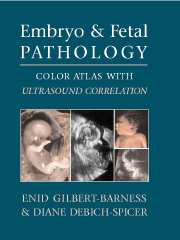Book contents
- Frontmatter
- Contents
- Foreword by John M. Opitz
- Preface
- Acknowledgments
- 1 The Human Embryo and Embryonic Growth Disorganization
- 2 Late Fetal Death, Stillbirth, and Neonatal Death
- 3 Fetal Autopsy
- 4 Ultrasound of Embryo and Fetus: General Principles
- 5 Abnormalities of Placenta
- 6 Chromosomal Abnormalities in the Embryo and Fetus
- 7 Terminology of Errors of Morphogenesis
- 8 Malformation Syndromes
- 9 Dysplasias
- 10 Disruptions and Amnion Rupture Sequence
- 11 Intrauterine Growth Retardation
- 12 Fetal Hydrops and Cystic Hygroma
- 13 Central Nervous System Defects
- 14 Craniofacial Defects
- 15 Skeletal Abnormalities
- 16 Cardiovascular System Defects
- 17 Respiratory System
- 18 Gastrointestinal Tract and Liver
- 19 Genito-Urinary System
- 20 Congenital Tumors
- 21 Fetal and Neonatal Skin Disorders
- 22 Intrauterine Infection
- 23 Multiple Gestations and Conjoined Twins
- 24 Metabolic Diseases
- Appendices
- Index
11 - Intrauterine Growth Retardation
Published online by Cambridge University Press: 23 February 2010
- Frontmatter
- Contents
- Foreword by John M. Opitz
- Preface
- Acknowledgments
- 1 The Human Embryo and Embryonic Growth Disorganization
- 2 Late Fetal Death, Stillbirth, and Neonatal Death
- 3 Fetal Autopsy
- 4 Ultrasound of Embryo and Fetus: General Principles
- 5 Abnormalities of Placenta
- 6 Chromosomal Abnormalities in the Embryo and Fetus
- 7 Terminology of Errors of Morphogenesis
- 8 Malformation Syndromes
- 9 Dysplasias
- 10 Disruptions and Amnion Rupture Sequence
- 11 Intrauterine Growth Retardation
- 12 Fetal Hydrops and Cystic Hygroma
- 13 Central Nervous System Defects
- 14 Craniofacial Defects
- 15 Skeletal Abnormalities
- 16 Cardiovascular System Defects
- 17 Respiratory System
- 18 Gastrointestinal Tract and Liver
- 19 Genito-Urinary System
- 20 Congenital Tumors
- 21 Fetal and Neonatal Skin Disorders
- 22 Intrauterine Infection
- 23 Multiple Gestations and Conjoined Twins
- 24 Metabolic Diseases
- Appendices
- Index
Summary
Estimation of fetal maturity is the most accurate method of estimating gestation age by ultrasonographic measurements of crown-rump length during the first trimester. From the first trimester through 34 weeks, the biparietal diameter is accurate to within 10 days. Other measurements used in the 2nd and 3rd trimesters include fetal abdominal diameter and femur length.
Low birth weight (LBW) is a worldwide problem usually defined as birth weight <2,500 g, irrespective of gestational age. It is associated with increased perinatal morbidity and is used as a marker of increased neonatal risk. It is not an ideal marker of fetal growth and development and combines both prematurity and various degrees of growth retardation.Morbitity is associated with LBW and growth retardation. Twenty-one million LBW infants are born each year internationally, 90% in developing countries.
Insulin growth factor (IGF) II is essential for organogenesis and early fetal growth. IGF-I is essential for late fetal growth. IGF-I is low in intrauterine growth retardation (IUGR) infants.
Proportion of LBWs varies by type of society:
■ 3–12% rates of LBW infants occur in developed countries, 60% premature, 40% growth retarded
■ 12–40% rates of LBW in developing countries, 20% premature, 80% growth retarded
There is a high rate of perinatal morbidity in growth-retarded infants:
■ perinatal depression is 3 times more likely
■ hypoglycemia is 4–6 times more likely
■ hypothermia is 5 times more likely
■ meconium aspiration is 13 times more likely
■ fetal distress in labor is 6 times more likely
- Type
- Chapter
- Information
- Embryo and Fetal PathologyColor Atlas with Ultrasound Correlation, pp. 310 - 320Publisher: Cambridge University PressPrint publication year: 2004



